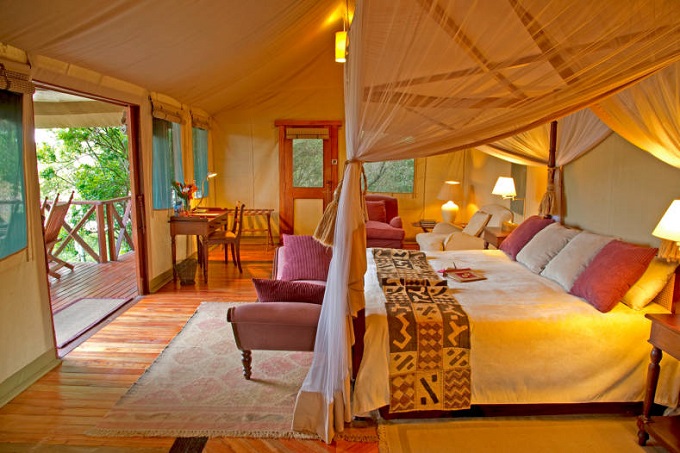THE Great Migration is undoubtedly one of Nature’s most unforgettable spectacles: 1.5 million wildebeest accompanied by 200,000 or so zebras are engaged in a never-ending journey, following the rains in a circular 1,200-mile route, through a wilderness that takes in the Serengeti National Park and Kenya's Masai Mara Game Reserve. After working as a naturalist for many years, Abdul Karim joined award-winning Sanctuary Olonana Camp eleven years ago where he now leads a team of six dedicated Sanctuary Retreats guides in the Masai Mara. One of Kenya’s most experienced guides. Karim answers some of the most frequently asked questions about Africa’s greatest spectacle. Where is the best location in the Masai Mara to experience the Migration? “There are five river crossing points that we regularly visit near Sanctuary Olonana Camp, which amongst the best places to experience the drama of the great Migration. Crocodiles and other predators such as lions, leopards and cheetahs also know where to wait and so usually see a kill at the crossings. The nearest crossing is at Kichwa Tembo airstrip, which is only a short drive from our lodge. “ Do the wildebeest cross the river once or multiple times? “The wildebeest are excellent at knowing where to find food. They can, quite literally, smell the rain from quite a distance, and know that where there’s rain, there is going to be grass for them to eat. In the Masai Mara it’s such a large area that it usually rains in one part and not in another, so the wildebeest often have to cross the treacherous Mara River multiple times during the migration to get to the pastures. Great for predators and spectators - not so great for the wildebeest!" How is the weather during the Migration? “We had the long rains this year from March to June, and now we are in what we call the ‘Kenyan winter’ – which basically means fresh and chilly mornings and evenings. It’s also quite cloudy, and showers aren’t uncommon. On the plus side, that means there is lots of food for wildebeest and zebra, which is why they are here in such huge numbers right now. However, it’s an El Niño year and this has meant the weather has been fairly unpredictable, and the long rains came in quite late.” When is the best time of day to photograph the Migration? “From long experience, I think the best time is either in the morning before 9am or in the afternoon after about 4pm. We usually go to the first crossing point quite early and, if it’s quiet, we’ll move on to the next one until we find one with the most activity. Of course it’s certainly possible to take good photographs in the middle of the day, but you need to be more of an expert photographer to get the best shots. If you are an amateur photographer like most of us, the light is much better in the morning and evenings – meaning better photos, which is what we all want.” When is the Migration in the Masai Mara? “This year, we first saw the Migration in the Masai Mara on 14 June, which is when we started to see wildebeest crossing the border from Tanzania and the Serengeti National Park. The crossing point into Kenya is about a half-day from Sanctuary Olonana Camp. Normally the wildebeest head back in late October, but can sometimes stay here until November or even December depending on how strong the season is.” What do guests like best about the Migration? “One of the most popular activities with Sanctuary Olonana guests is a bush dinner held on site close to one of the river crossings. There is something quite surreal about indulging in some gourmet fine dining against a background of wildebeest gurgling and grunting nearby. Guests also enjoy picnicking close to a crossing where they can relax and sit back and enjoy the what are quite literally, front row seat to the Great Migration. And of course, a traditional ‘sundowner’ or two at about 6:30pm is everyone’s favourite time on safari, especially during the Migration!”  What have you noticed about the Migration, having experienced it for many years? What have you noticed about the Migration, having experienced it for many years?
“Well I always think it’s extraordinary that there are a couple of established bridges which cross the Mara River, and the wildebeest never use them! They always choose to take their chances with the crocodiles and the predators, and cross through the waters. I guess it’s just nature – and the survival of the fittest, at work. I’ve also noticed that 2016 seems to be an especially big year for the Migration, with all the guides saying they have never seen so many wildebeest in the Masai Mara.” What other wildlife do you see in the migration? “Apart from wildebeest, zebra also get swept up in all the excitement, as do topi antelope, and they all make the river crossings together. It’s quite predictable where the animals will cross and crocodiles know where to wait so that they can make their kills. Usually they scare the wildebeest by attacking them as they cross, and then the wildebeest back off and rest for a while, before starting up again in the hope that the crocodiles have moved on. But of course, they are still patiently waiting for their next meal! And we always see many lions, leopards and cheetahs at this time of year as well.” Luxury Link: www.sanctuaryretreats.com Sanctuary Retreats’ extended stay offer at Sanctuary Olonana luxury camp. Priced from US$210 per person per night twin share (normally US$350) based on 8+night stays.
Lisa Edwards 15/8/16 |